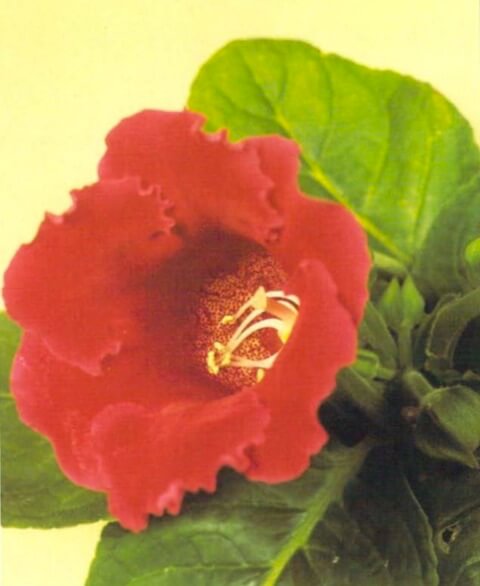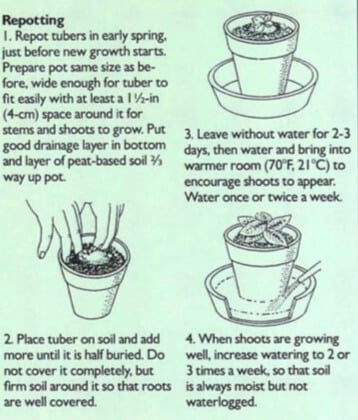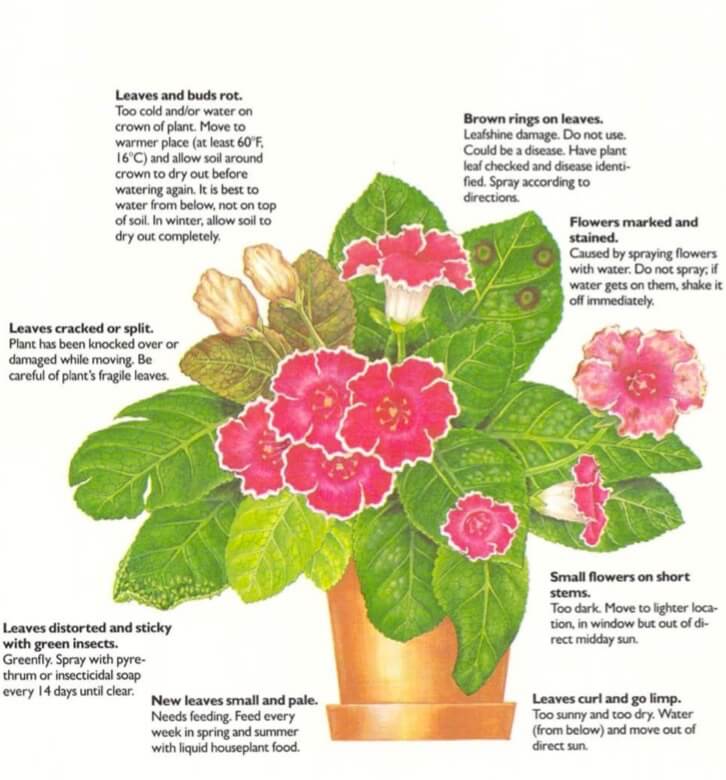[Ebook Việt Hoá] The Instant Guide to Healthy Houseplants (Hướng dẫn tức thời để chăm cây trong nhà khoẻ mạnh), Chi Sinningia
[Ebook Việt Hoá] The Instant Guide to Healthy Houseplants: Sinningia speciosa (Gloxinia)
- Nguồn: [Ebook Việt Hoá] The Instant Guide to Healthy Houseplants (Hướng dẫn tức thời để chăm cây trong nhà khoẻ mạnh)
- Biên tập: Dũng Cá Xinh
- Biên dịch: Team Codai.net
English
One of the most beautiful of summer plants, the gloxinia can, with a little care and attention, be cultivated for more than a season. The size and quality of its blooms deteriorate after two or three years, however, when it may be better to start again. It is also difficult to transport, as its wide, Bat leaves crack and break easily. The plant’s trumpet-shaped flowers are carried singly on stems about 8 inches (20 cm) above the leaves. They are available in many colors, including red, white, mauve, pink and multi-colors.

Light
Needs plenty of light, but avoid direct midday sun.
Temperature
Summer indoors, 60-70°F (16-21°C). Plants should die down in autumn and the tubers stored in a dry place; minimum, 40°F (4°C). Early spring (to start new growth), 70°F (21 °C).
Water
Water 3 times a week in summer; reduce frequency in autumn until plant has completely dried. Water must not touch crown (center) of plant.
Feeding
When growing in spring and summer, feed weekly with liquid houseplant food diluted according to manufacturer’s instructions.
Humidity
Spray with fine mist of tepid water daily when growing, avoiding flowers. Shake surplus off leaves. Provide humidity by standing pot on saucer of pebbles almost covered with water or in outer container with damp peat.
Cleaning
Humidity spraying is sufficient. Use no leafshine.
Repotting
For young plants grown from seed or cuttings, repot 2-3 times in first year; for old tubers, repot each year in fresh soil when winter rest period is over. Use same-sized pot as before, allowing tuber to fit comfortably across width of pot. Half bury tubers in soil, leaving tops exposed.
- 1. Repot tubers in early spring, just before new growth starts. Prepare pot same size as before, wide enough for tuber to fit easily with at least a 1 1/2-in (4 cm) space around it for stems and shoots to grow. Put good drainage layer in bottom and layer of peat-based soil 1/3 way up pot.
- 2. Place tuber on soil and add more until it is half buried. Do not cover it completely, but firm soil around it so that roots are well covered.
- 3. Leave without water for 2-3 days, then water and bring into warmer room (70°F, 21 °C) to encourage shoots to appear. Water once or twice a week.
- 4. When shoots are growing well, increase watering to 2 or3 times a week, so that soil is always moist but not waterlogged.

What goes wrong

- Leaves and buds rot: Too cold and/or water on crown of plant. Move to warmer place (at least 60°F, 16°C) and allow soil around crown to dry out before watering again. It is best to water from below, not on top of soil. In winter, allow soil to dry out completely.
- Leaves cracked or split: Plant has been knocked over or damaged while moving. Be careful of plant’s fragile leaves.
- Brown rings on leaves: Leafshine damage. Do not use. Could be a disease. Have plant leaf checked and disease identified. Spray according to directions.
- Flowers marked and stained: Caused by spraying flowers with water. Do not spray; if water gets on them, shake it off immediately.
- Leaves distorted and sticky with green insects: Greenfly. Spray with pyrethrum or insecticidal soap every 14 days until clear.
- New leaves small and pale: Needs feeding. Feed every week in spring and summer with liquid houseplant food.
- Small flowers on short stems: Too dark. Move to lighter location, in window but out of direct midday sun.
- Leaves curl and go limp: Too sunny and too dry. Water(from below) and move out of direct sun.
Tiếng Việt
Một trong những loài cây đẹp nhất của mùa hè, cây tử la lan, với một chút chăm sóc và chú ý, có thể được trồng trong hơn một mùa. Tuy nhiên, kích thước và chất lượng của các bông hoa sẽ xấu đi sau hai hoặc ba năm, khi bắt đầu lại thì có thể tốt hơn. Việc vận chuyển cũng khó khăn vì lá rộng, dễ nứt, gãy. Những bông hoa hình loa kèn của cây mọc đơn lẻ trên thân cây cách lá khoảng 20 cm (8 inch). Chúng có nhiều màu, bao gồm đỏ, trắng, hoa cà, hồng và nhiều màu

Ánh sáng
Cần nhiều ánh sáng, nhưng tránh ánh nắng trực tiếp giữa trưa.
Nhiệt độ
Mùa hè trong nhà nhiệt độ khoảng 60-70 độ F (16-21 độ C). Cây sẽ chết vào mùa thu và củ được bảo quản ở nơi khô ráo; tối thiểu, 40 độ F (4 độ C). Đầu mùa xuân (để bắt đầu tăng trưởng mới), 70 độ F (21 độ C).
Tưới nước
Tưới nước 3 lần / tuần vào mùa hè; giảm tần suất vào mùa thu cho đến khi cây khô hoàn toàn. Nước không được chạm vào đỉnh (giữa) của cây.
Bón phân
Khi phát triển vào mùa xuân và mùa hè, bón phân hàng tuần bằng phân bón dạng lỏng được pha loãng theo hướng dẫn của nhà sản xuất .
Độ ẩm
Phun sương mịn hàng ngày khi cây đang phát triển, tránh hoa tàn. Lắc phần thừa ra khỏi lá. Cung cấp độ ẩm bằng cách đặt chậu trên đĩa sỏi gần như phủ nước hoặc trong thùng bên ngoài có than bùn ẩm.
Làm sạch
Phun ẩm vừa đủ. Không sử dụng xịt bóng lá.
Thay chậu
- 1. Thay củ vào đầu mùa xuân, ngay trước khi cây mới bắt đầu phát triển. Chuẩn bị chậu có kích thước tương tự như trước đây, đủ rộng để củ có thể vừa khít với khoảng cách ít nhất là 1/4 inch (4 cm) xung quanh để thân và chồi phát triển. Đặt lớp thoát nước tốt dưới đáy và lớp đất than bùn từ 1/3 chiều lên của chậu.
- 2. Đặt củ trên đất và thêm nhiều đất hơn nữa cho đến khi nó được chôn một nửa. Không phủ hoàn toàn mà nên làm chắc đất xung quanh để rễ được che phủ tốt.
- 3. Để không có nước trong 2-3 ngày, sau đó tưới nước và đưa vào phòng ấm hơn (70 độ F, 21 độ C) để kích thích chồi nở. Tưới nước một hoặc hai lần một tuần.
- 4. Khi chồi đang phát triển tốt, tăng cường tưới nước lên 2 hoặc 3 lần một tuần, để đất luôn ẩm nhưng không bị úng.

Những vấn đề có thể xảy ra

- Lá và chồi bị thối: Quá lạnh hoặc tưới trên ngọn cây. Di chuyển đến nơi ấm hơn (ít nhất 60 độ F, 16 độ C) và để đất xung quanh thân cây khô trước khi tưới lại. Tốt nhất là tưới từ bên dưới, không tưới lên trên mặt đất. Vào mùa đông, để đất khô hoàn toàn.
- Lá bị nứt hoặc tách: Cây bị đổ hoặc bị hư hại trong khi di chuyển. Hãy cẩn thận với những chiếc lá mỏng manh của cây.
- Các vòng màu nâu trên lá: Hư hại do xịt bóng lá. Không được dùng. Có thể là một căn bệnh. Kiểm tra lá cây và xác định bệnh. Xịt theo hướng dẫn.
- Hoa có vết bị loang màu: Nguyên nhân do xịt nước vào hoa. Không xịt; nếu nước dính vào chúng, hãy giũ bỏ nó ngay lập tức.
- Lá méo mó và dính sâu bọ xanh: Ruồi xanh. Xịt bằng thuốc trừ sâu hoặc xà phòng diệt côn trùng 14 ngày một lần cho đến khi sạch bệnh.
- Lá mới nhỏ và nhợt nhạt: Cần nuôi dưỡng. Bón phân hàng tuần vào mùa xuân và mùa hè bằng phân bón lỏng.
- Hoa nhỏ trên thân ngắn: Quá tối. Di chuyển đến vị trí sáng hơn, trong cửa sổ nhưng tránh ánh nắng trực tiếp giữa trưa.
- Lá quăn queo, mềm nhũn: Nắng quá và khô quá. Tưới nước (từ bên dưới) và tránh nắng trực tiếp.
![[Ebook Việt Hoá] The Instant Guide to Healthy Houseplants: Sinningia speciosa (Gloxinia) [Ebook Việt Hoá] The Instant Guide to Healthy Houseplants: Sinningia speciosa (Gloxinia)](https://vn1.vdrive.vn/codai.net/2020/02/ebook-huong-dan-tuc-thoi-cham-cay-trong-nha-khoe-manh-13-sinningia-speciosa.jpg)


